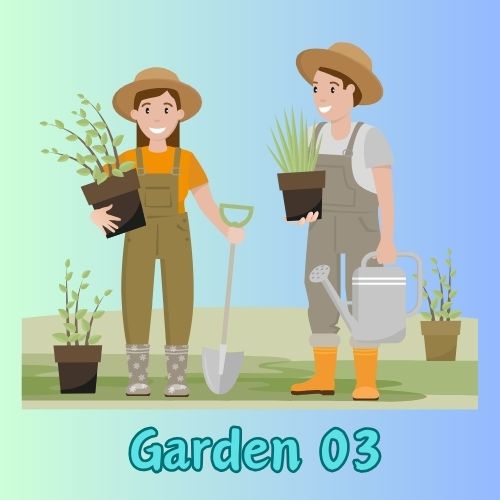Bleeding heart plants are among the most enchanting and eye-catching perennials in the gardening world, admired for their heart-shaped blooms that dangle delicately from arching stems. These plants are not only beautiful but also relatively easy to grow from seeds. In this comprehensive guide, Garden 03 will explore everything you need to know about growing bleeding heart plant seeds, from seed selection and planting to ongoing care and maintenance.
1. Introduction to Bleeding Heart Plants
Bleeding heart plants, scientifically known as Dicentra spectabilis, are native to Asia and North America. Their signature pink or white heart-shaped flowers have made them a favorite in gardens around the world. The plant blooms in spring, producing clusters of flowers that dangle like small hearts, giving it its charming name.
These plants prefer shade to partial shade, making them ideal for woodland gardens, shaded borders, or any spot in your garden where direct sunlight is limited. One of the best ways to introduce bleeding hearts to your garden is by growing them from seeds.
2. Why Grow Bleeding Heart Plants from Seeds?
Growing bleeding heart plant seeds offers numerous benefits, especially for gardeners who love to nurture plants from their very beginning. Here’s why you might consider starting from seeds:
- Cost-Effective: Purchasing seeds is typically more affordable than buying established plants, especially if you want to plant a large number of bleeding hearts in your garden.
- More Varieties: Growing from seeds gives you access to a wider variety of bleeding heart species and cultivars.
- Satisfaction: There’s something incredibly rewarding about growing a plant from seed and watching it develop into a full-grown, flowering perennial.
- Natural Propagation: Growing from seeds allows the plants to establish naturally and can lead to stronger, more resilient plants over time.
3. Selecting and Buying Bleeding Heart Plant Seeds

Before you start planting, it’s crucial to choose the right bleeding heart plant seeds. You can find seeds at local garden centers, nurseries, or online retailers. There are a few important factors to consider when selecting your seeds:
3.1 Types of Bleeding Heart Plants
There are several varieties of bleeding heart plants to choose from, each with its own unique characteristics:
- Dicentra spectabilis (Common Bleeding Heart): The classic variety with arching stems and pink flowers, often blooming in early spring.
- Dicentra spectabilis ‘Alba’: A white-flowered version of the common bleeding heart.
- Dicentra formosa (Western Bleeding Heart): Native to the western United States, this variety has smaller flowers and is more compact.
- Dicentra eximia (Fringed Bleeding Heart): A variety that produces clusters of pink flowers with fern-like foliage.
Each variety has its own growing preferences and visual appeal, so choose the one that fits best with your garden aesthetic.
3.2 Purchasing Quality Seeds
When purchasing seeds, look for these qualities:
- Fresh Seeds: Seeds lose viability over time, so choose seeds harvested recently.
- Reputable Sellers: Purchase from trusted suppliers to ensure you’re getting high-quality, viable seeds.
- Organic and Non-GMO Options: If you prefer a more natural approach to gardening, opt for organic seeds that are free from genetic modifications.
4. How to Plant Bleeding Heart Plant Seeds
Now that you’ve selected your seeds, it’s time to plant them. The process of planting bleeding heart plant seeds requires a bit of patience, as these seeds need a cold stratification period to break dormancy and germinate.
4.1 Cold Stratification
Bleeding heart seeds need to experience a period of cold temperatures to mimic winter conditions. This process, called cold stratification, helps to break the seeds’ dormancy and encourages germination.
Steps for Cold Stratification:
- Moisten a Paper Towel: Dampen a paper towel or cotton ball, ensuring it’s moist but not soggy.
- Place Seeds in the Towel: Spread the bleeding heart plant seeds evenly on the towel.
- Store in a Plastic Bag: Place the towel and seeds in a zip-lock plastic bag.
- Refrigerate: Store the bag in the refrigerator for 6-8 weeks. Keep the seeds in a cool, consistent temperature around 35-40°F (1.5-4°C).
- Check for Moisture: Occasionally check to make sure the towel remains moist.
4.2 Planting the Seeds
Once the cold stratification period is complete, you can plant the seeds.
Steps for Planting:
- Choose the Right Soil: Bleeding hearts prefer well-drained, loamy soil rich in organic matter. If the soil is too heavy or waterlogged, the seeds may rot.
- Sow the Seeds: Plant the seeds about 1/4 inch deep in the soil. You can start the seeds indoors in seed trays or directly outdoors in a shaded area.
- Watering: Keep the soil consistently moist but not waterlogged. Ensure the soil stays damp to encourage germination, which typically takes 3-4 weeks.
- Light Conditions: Bleeding heart seeds prefer to germinate in partial shade. If you’re starting them indoors, make sure they receive filtered sunlight or grow lights.
5. Transplanting Bleeding Heart Seedlings
After the seeds have germinated and the seedlings have grown a few inches tall, it’s time to transplant them outdoors. The best time to transplant bleeding heart seedlings is in the spring or early fall, when temperatures are mild and not too hot.
5.1 Hardening Off Seedlings
Before transplanting, it’s important to harden off the seedlings. This process gradually acclimates the young plants to outdoor conditions.
Steps for Hardening Off:
- Start Indoors: Keep the seedlings indoors and reduce watering slightly to strengthen them.
- Gradual Exposure: Over 7-10 days, place the seedlings outside for increasing periods each day, starting with 1-2 hours in a shaded area and gradually increasing to 6-8 hours.
- Monitor Conditions: Ensure the seedlings are protected from wind, direct sunlight, and extreme temperatures during the hardening off process.
5.2 Transplanting into the Garden
Once the seedlings are ready, plant them in a prepared garden bed.
- Spacing: Bleeding heart plants need plenty of room to grow. Space the seedlings about 18-24 inches apart to give them room to spread.
- Depth: Dig holes deep enough to cover the root ball without burying the stems.
- Mulching: Add a layer of mulch around the base of the seedlings to help retain moisture and suppress weeds.
6. Caring for Bleeding Heart Plants
Once your bleeding heart plant seeds have germinated and been transplanted into your garden, the key to a healthy, thriving plant is ongoing care. Here are some tips to help your plants flourish.
6.1 Watering
Bleeding heart plants prefer consistently moist soil, especially during the growing season. However, they do not like to be waterlogged.
- Water deeply at the base of the plant, ensuring the soil stays damp but not soggy.
- During dry spells, water more frequently to prevent the plant from drying out.
- Avoid overhead watering, as wet leaves can promote fungal diseases.
6.2 Fertilizing
Bleeding heart plants benefit from nutrient-rich soil, but they don’t require excessive fertilization.
- Organic Compost: Incorporate compost or well-rotted manure into the soil at the beginning of the growing season to provide essential nutrients.
- Balanced Fertilizer: Apply a balanced fertilizer (10-10-10) in early spring when new growth begins. Avoid over-fertilizing, as this can lead to excessive foliage growth at the expense of flowers.
6.3 Pruning and Deadheading
Bleeding heart plants don’t require extensive pruning, but removing spent flowers and old growth can help maintain their health and appearance.
- Deadheading: Remove faded or dead flowers to encourage the plant to produce more blooms.
- Cut Back After Blooming: Once the plant has finished blooming in late spring or early summer, cut back the foliage to tidy up the garden and make room for new growth.
7. Common Pests and Diseases
While bleeding heart plants are relatively pest-resistant, they can still fall victim to some common pests and diseases.
7.1 Pests
- Aphids: These small insects can suck sap from the plant, causing the leaves to curl and distort. Use insecticidal soap or neem oil to treat aphid infestations.
- Slugs and Snails: These pests can chew through the leaves, leaving holes and ragged edges. Use slug pellets or organic barriers like crushed eggshells to protect the plant.
7.2 Diseases
- Leaf Spot: Fungal diseases like leaf spot can cause dark spots on the foliage. To prevent leaf spot, avoid overhead watering and ensure proper spacing for air circulation.
- Powdery Mildew: This fungal disease causes a white, powdery coating on the leaves. Treat with fungicide or neem oil and ensure good air circulation.
8. Propagating Bleeding Heart Plants
In addition to growing from bleeding heart plant seeds, propagating these plants through division or cuttings is an effective way to multiply your plants and maintain their health. These methods can be easier and faster than growing from seeds, providing you with mature plants more quickly.
8.1 Propagation by Division
Division is one of the simplest and most reliable methods for propagating bleeding heart plants. It’s best done in early spring or fall when the plant is dormant.
Steps for Division:
- Dig Up the Plant: Carefully dig up the mature bleeding heart plant, being cautious not to damage the root system.
- Separate the Root Clumps: Gently separate the root ball into smaller sections, ensuring that each division has several roots and at least one growing shoot.
- Replant Divisions: Replant each division in well-prepared soil, spacing them 18-24 inches apart. Water the plants thoroughly after replanting.
Division helps to rejuvenate older plants and encourages new growth.
8.2 Propagation by Cuttings
Cuttings are another method to propagate bleeding hearts. While slightly more difficult than division, it’s still a viable option.
Steps for Cuttings:
- Select a Healthy Stem: Choose a healthy, non-flowering stem about 4-6 inches long.
- Cut Just Below a Node: Use a sharp, sterile knife to cut just below a leaf node.
- Prepare the Cutting: Remove the lower leaves, leaving only a few at the top. Dip the cut end in rooting hormone to encourage faster root development.
- Plant the Cutting: Place the cutting in a well-draining potting mix, ensuring that the cut end is buried about an inch deep.
- Maintain Moisture: Keep the potting mix moist and place the cutting in a warm, shaded area. Roots should develop within 3-4 weeks.





